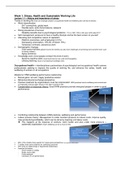Week 1: Stress, Health and Sustainable Working Life
Lecture 1.1 – History and importance of stress
Trends in working life (that can endanger people’s occupational health and wellbeing and can lead to stress):
• Work intensification
- 24/7 connectivity, global work
- Flexible work, work-home balance, telework
• Rising prevalence of burnout
- Disability benefits due to psychological problems: 11% in 1967, 30% in 90’s and >40% after 2017
• Self-management: pressure to have a healthy lifestyle and be the best version of yourself
• Alienating and competitive nature of capitalism
- Platform economies, self-employment (12%)
- Decreasing unionization, 19% NL (Finland: 70%)
- Temporary contracts, precarious work
• Demographic changes
- Dual-career-families (greater income for families, but also more challenges of combining work and other stuff, such
as raising children)
- Aging workforce
• Knowledge work (most people conduct this kind of work)
- Social & cognitive skills (meaning those two are used interchangeably)
- Lifelong learning (result of conducting knowledge work)
Occupational health = interdisciplinary partnerships of psychological and occupational health science
professionals seeking to improve the quality of working life, and enhance the safety, health, and
wellbeing of workers in all occupations
Models for HRM-wellbeing-performance relationship:
• Mutual gains: win-win, happy productive worker
• Behavioural/social exchange perspective
• Positive treatment by organizations must be reciprocated: HRM practices lead to wellbeing and commitment
of employees and that again results in the effort to perform well
• Conservation of resources theory: Good HRM practices provide energized people in order to good
performance
• Conflicting relationship between HRM practices, wellbeing and performance
• Labour process theory: Management is under constant pressure to reduce costs, improve quality,
raise productivity/profitability, which can be done by lowering unit labour costs
➔ This happens at the expense of workers: work harder and also under more pressure =
systematic exploitation (lower wellbeing can be a result of this)
• 66% of the models show support for mutual gains perspectives (only positive relationships)
• 5 studies show some evidence for conflicting outcomes
• 22% show no relationships or fragmented relationships
• Important limitations:
- Small number of studies
- Single source data
- Cross-sectional
- Individual OR unit performance
,Bad work = stress
Good work = no stress? (is this the case?)
Stress = a state of mental or emotional strain or tension resulting from adverse or demanding
circumstances
• Stress research: history (mainly focused on psychological stress reactions under stressful conditions → stress mainly
examined in framework of stimulus response)
• From physiological/behaviouristic perspectives…
- All of the non-specifically induced changes within a biologic system in response to an aggressive
outside agent, that is, the stressor
- Stress results from disturbance of homeostasis (i.e. the body’s attempt to maintain the stable internal
environment)
- Fight-or-flight (Cannon, 1932) & GAS (Selye, 1955)
Fight-or-flight GAS (General Adaptation Syndrome)
- Allostatic Load Model
Stability through change
Allostatic state = reset of set points due exposure to chronic demands
Allostatic load = symptoms and pathology caused by chronic allostatic state
… to psychological perspectives:
- Role and importance of cognition in experiencing stress
Stress is…
• an interaction of:
- features of the environment/events (= stressors)
- an individual’s response (psychological, physiological, and
behavioural) to environmental demands, threats, and challenges
(= strain)
• a particular relationship between the person and environment that is
appraised by the person as taxing or exceeding his/her resources
and endangering his/her wellbeing
,Stressful life events:
• Stressors can…
- affect human health in nonspecific ways
- cause a variety of illnesses
• SLE = events that cause different degrees of social readjustment
• Bridge from research interest in general life stress to work-related stress
Symptoms of stress:
• Physical
- Fatigue
- Muscular tension
- Headaches
- Heart palpitations
- Sleeping difficulties
- Gastrointestinal problems
- Dermatological disorders
• Psychological
- Burnout (exhaustion, cynicism, lack of accomplishment)
- Depression
- Anxiety
- Irritability
- Pessimism
- Feelings of being overwhelmed and unable to cope
- Cognitive difficulties (e.g. concentration problems, mistakes)
• Behavioural
- Irritability
- Withdrawal behaviours: absenteeism, turnover
- Aggression
- Low work performance
- Impatience
- Disinterest
- Isolation
- Poor health behaviours (e.g. eating, exercising, drug abuse)
- Risk taking (e.g. unsafe driving)
Stressors ➔ conditions, situations or events that cause strain:
• Temporary, intermittent or chronic
• Type of stressors:
- Physical stressors (heat, poor ergonomics, lighting)
- Task-related stressors (repetitive tasks, workload)
- Role stressors (role ambiguity, inter-role, intra-role)
- Social stressors (bullying, conflicts, poor management)
- Work-schedule related stressors (long work hours, shift work, availability)
- Career-related stressors (unclear or unfair performance evaluation systems, job insecurity)
- Stressful change process (downsizing, merger or acquisition)
, Why should we care about stressors? ➔ how is stress important for HRM?
• Levels of perceived job insecurity have increased over time & highest levels of this perceived
insecurity has found to be in low-skilled work
• Level of time pressure (tight deadlines) has increased over the last couple of years → more stress
• 30% of workers feel like the organization is not handling work-related stress well → this is worrying
because 1/4 of the workers feel like work affects their health negatively
How does stress exactly affect health?
➔ Strongest link found between job stress & gastro-intestinal (stomach & intestines) problems and
sleep disturbances
➔ Link between subjective stress & cardiovascular mortality (dying because of a heart disease)
How stress is related to physical/mental health of workers & how this affects society ➔ societal burden
of stress:
• Direct
- Medical (hospital admissions, physician fees, medication)
- Non-medical (insurance, litigation, travel costs, etc.)
• Indirect
- Productivity loss (sickness absence, turnover, presenteeism, etc.)
• Intangible (hard to estimate)
- Pain, suffering, loss of quality of life (willingness to pay?)





